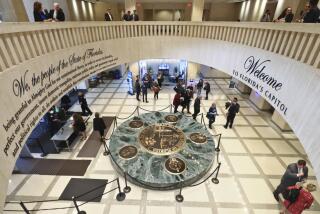History Squarely at Odds With Progress in Beijing
BEIJING — Turn off the main road and step into yesterday--past the cramped greasy spoon, past walls that stood through centuries of emperors, past crumbling gray-brick homes slathered with one huge painted Chinese character: “chai”--demolish.
This is Nanchizi, a half-mile from the imperial Forbidden City and one of the abundant but dwindling warrens of confounding alleys and courtyard homes that have dotted central Beijing since the 12th-century Mongol invasion.
Long ago, a prince lived here, and scholars from the Qing court next door visited Pudu Temple to study. But in recent years, stately courtyards have grown ramshackle, overcrowded and, the government says, inadequate for a metropolis striving to be China’s showpiece. Plumbing has collapsed; houses are crumbling; for some residents, toilets are 100 yards away.
Already, most of it is no more. Its modern replacement, designed to mimic the old houses in outward appearance, will rise with strong foundations, reliable plumbing and electricity--and far less of the character that carried the neighborhood through three dynasties and two republics. Longtime residents will be swept away, relocated; some will return and pay higher prices.
As Beijing hurtles toward a future brimming with development, foreign investment and an economy-boosting Olympic Games, a tension plays out across the city that has been China’s capital for much of a millennium. It’s a problem that vexes many of the world’s ancient metropolises, from Jerusalem to Jakarta, as they enter the 21st century: Progress or preservation?
Unlike many cities, though, Beijing has no master renovation plan for residents to peruse at City Hall, no open appeals process where preservationists and residents can lodge objections. For the government, the answer seems simple--too simple, some say. It is solving matters in its own way: by giving orders, and by shuffling people around.
“Preservation should always be the priority,” says Wang Jianqing, the deputy director of Beijing’s Dongcheng District, where Nanchizi is located. Moments later, he adds: “Our aim is to improve people’s living conditions.”
“The balance,” he acknowledges, “is very complicated.”
Tourism--and growing national pride in a fascinating history--is nudging the government toward preservation efforts that will showcase Beijing as the ancient emblem of an ancient nation.
But China’s push toward development runs deep--not only for a new generation of savvy entrepreneurs but as a staple of Mao Tse-tung’s decades-old party doctrine of “jianguo,” a patriotic phrase that means “build the nation.”
In the 1970s, when Asian nations like Singapore and Malaysia were beginning building booms to coincide with business growth and population explosions, China was still wrapped in communist insularity and parents were naming their children Jianguo.
It has spent the past decade playing catch-up. Now it has nabbed the 2008 Olympics and joined the World Trade Organization, and every taxi sports a local radio station’s banner that says, in English and Chinese, “Build New Beijing, Host Great Olympics.”
To preserve the old, the government has designated 25 special protection areas, where it insists history comes first. Official newspapers trumpet preservation projects from remnants of the old city wall to the homes of celebrated writers.
But the government is also keen to ease population density and quality-of-life problems in the central city, where an estimated 1.17 million residents live in “dangerous and old houses.” Some 70,000 households have been “renovated,” a term the city won’t define. More than 85,000 families have been relocated to ease central Beijing’s population crunch. Hundreds of tons of rubble--including stones possibly dating back more than seven centuries to Marco Polo’s day--have been cleared.
Critics worry that the flurry of ambitious projects--particularly those that claim old courtyard houses and circuitous honeycombs of alleys called “hutongs”--are sweeping away Beijing’s history.
Fang Yong, a professor at Beijing University’s Architecture Institute, has sounded a note of caution to developers. Even diligent renovation, Fang says, distorts what the buildings once were.
“It’s a paradox, really--preserve the hutongs and courtyard houses, or improve people’s lives and develop the city,” Fang said. “In theory, few people are against preserving hutongs. In reality, it is a difficult thing to achieve. But if we lose this architecture, we lose it forever.”
“The alleys in Beijing are the carrier of history,” says the foreword to a local guidebook of the city’s hutongs. Trouble is, history doesn’t always fit easily into the modern world.
The hutongs and their showpieces--quadrangle courtyards--were the staple of old Beijing. Many were laid out to exacting standards of feng shui, the ancient Chinese philosophy of designing one’s house in accordance with nature’s forces, and housed aristocrats who needed access to the imperial palace.
Some were named for what was peddled there--Salt Shop Lane, Fresh Beans Lane, Glutinous Rice Alley. Not all were opulent; many were hodgepodges of dwellings and shops populated by the “laobaixing,” or common folk.
In the five years after Mao’s Communists took power in 1949, Beijing’s population grew from 1 million to 5 million. Housing pressures turned many alley neighborhoods into slums. Courtyards subdivided until a dozen families were living where one once did.
According to a survey by China Today magazine, Beijing has 360 major hutongs and more than 4,550 smaller lanes and alleys. But they are falling, one by one, as land grows more valuable and alley-style residences seem ever quainter.
The government’s method: Move people out of blighted old property, tear down, rebuild. Months later, residents who want to return are re-imported--but pay higher prices for the new versions of their homes.
And the displaced? “They go to stay with their relatives or friends,” says Li Haijun, vice governor of Chongwen District near central Beijing.
In Chongwen, at a place called the Goldfish Pool, workers are rebuilding a vast swath of dilapidated housing into a gleaming complex that stretches to the horizon. Nearby, factory worker Ding Guo and his wife, Yang Yun, rhapsodize about their new home, built atop their previous one.
Ding, who grew up in an old-style alley house and spent 10 years in its cinder-block replacement, now sits in a gleaming two-bedroom apartment in a six-story complex where many childhood friends still live.
“Now we can be in the middle of Beijing and still live well,” Ding says, offering a visitor dried fruit. Watching from nearby is a government official who picked him to receive foreign guests.
“History and progress?” his wife says. “I think they’re balancing it.”
Outside, government operatives in sunglasses and leather jackets sit at the ready. Talk to residents who haven’t been approved and they menacingly shoo you off.
On a crisp Sunday morning in Nanchizi, workers perch on rooftops with pickaxes, hammers and hands, methodically reducing a neighborhood to rubble. Kids play in honeycombs of old dwellings, clambering through the bedrooms of a thousand yesterdays. From atop brick piles, Forbidden City rooftops are visible beyond the walls.
By December, according to the Beijing Daily, 511 households had been moved out of 93 courtyards in Nanchizi’s pilot project to preserve historical architecture while fixing what “has degenerated into blocks of miscellaneous people living together in crowded conditions.”
Commercial properties aren’t exempt. Xiao Wangfu, a popular restaurant in an old building in central Beijing, was serving deep-fried pork ribs one evening and was gutted the next.
“Olympics,” explained a passer-by.
Not everyone’s happy. Blocked from her home in Nanchizi by a pile of masonry, a woman walking her bicycle weaves around it and curses the workers on the rooftop above.
“Our neighborhood is coming down around us!” she shouts. She gives only her surname, Hua. The demolition crew looks on, bemused.
“Nobody cares about the common people,” she snaps. “Progress? It’s not progress to me.”
The government promises to protect Nanchizi’s heritage. But scale models suggest only four old houses and the temple will be spared; everything else will face the “demolish” order.
In Nanchizi, when a pickax strikes a wall, the masonry bleeds history. But do residents--and their government--not have a right to basic improvements in their capital city?
As old structures fall and new ones rise, Beijing’s answers to questions like this will determine just what “building the nation” means--and what kind of city the world will see when the 2008 Olympics arrive.
More to Read
Sign up for Essential California
The most important California stories and recommendations in your inbox every morning.
You may occasionally receive promotional content from the Los Angeles Times.










